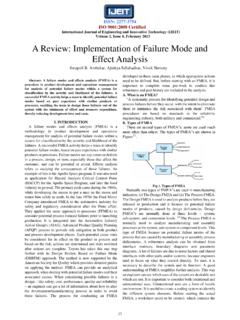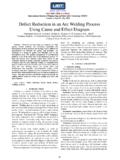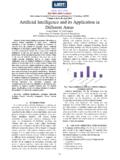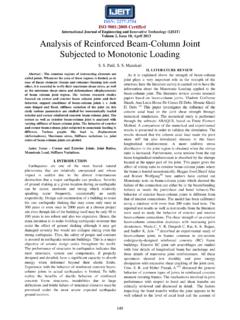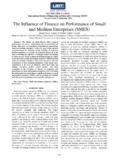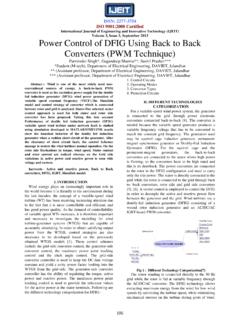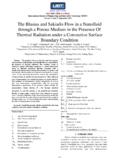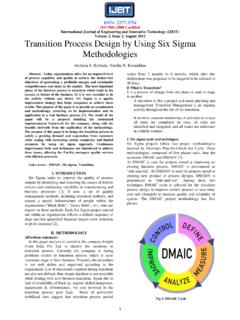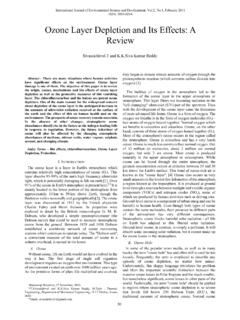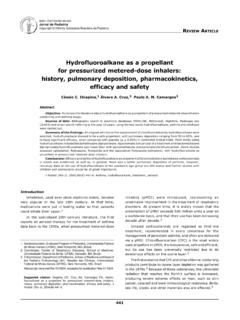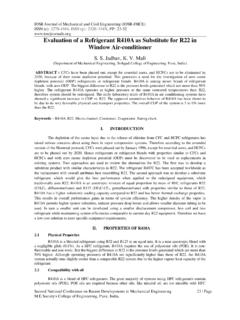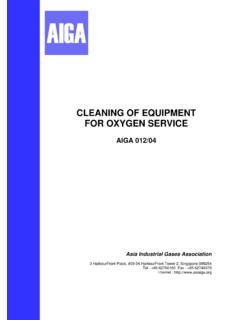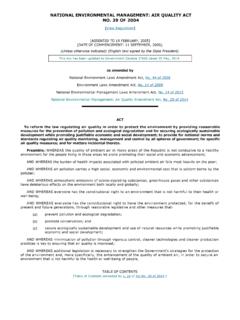Transcription of Evaluation of Vapour Compression Refrigeration …
1 ISSN: 2277-3754 ISO 9001:2008 Certified International Journal of Engineering and Innovative Technology (IJEIT) Volume 2, Issue 4, October 2012 39 Abstract-The performance of heat transfer is one of the most important research areas in the field of thermal engineering. There are a large number of refrigerants, which are used to transfer heat from low temperature reservoir to high temperature reservoir by using Vapour Compression Refrigeration system. There are various obstacles faced in working of different refrigerants due to their environmental impact (R11, R12), toxicity (NH3), flammability (HC) and high pressure (CO2); which makes them more hazardous than other working fluids according to safety and environmental issues.
2 Researchers observed the performance of different environmental friendly refrigerants and their mixtures in different proportions. They also observed the effect of working parameters like dimensions of capillary tube, working pressures and working temperatures, which affect the coefficient of performance (COP) of Vapour Compression Refrigeration system. From the literature there seems to be need of new efficient, minimum global warming potential (GWP), minimum ozone depletion potential (ODP) and environmental friendly refrigerants. Index Terms Vapour Compression Refrigeration System, Refrigerant, COP, ODP, GWP.
3 I. INTRODUCTION Vapour Compression Refrigeration system is a system which is used to transfer heat from low temperature reservoir to high temperature reservoir with the help of working fluid, called refrigerant. There are different types of refrigerant, which were used as the working medium in Vapour Compression Refrigeration system in the last few decades, but they cause of ozone layer depletion and green house effect. A. Refrigeration System: Working Principle and Construction Refrigeration system is based upon the Clausius statement of second law of thermodynamics.
4 This statement shows, It is impossible to construct a device which, operating in a cycle, will produce no affect other than the transfer of heat from a cooler to a hotter body. The construction of Vapour Compression Refrigeration system is illustrated in figure 1. This system consists of four basic components, a compressor, an evaporator, a condenser and capillary tubes. Here the compressor delivery head, discharge line, condenser and liquid line form the high pressure side of the system. The expansion line, evaporator, suction line and compressor suction head form the low pressure side of the system.
5 In plants with a large amount of refrigerant charge, a receiver is installed in the liquid line. A drier is also installed in the liquid line. The drier contains silica gel and absorb traces of moisture presented in the liquid refrigerants so that it does not enter the narrow cross section of the expansion device causing moisture chocking by freezing. Fig 1: Schematic of the Vapour Compression Refrigeration System [5]. B. Processes Involved in Vapour Compression Refrigeration System: Fig 2: Pressure-Enthalpy Graph for Vapour Compression Refrigeration System [11]. Process 1 2: Isentropic Compression in compressor.
6 Process 2 3: Constant pressure heat rejection in condenser. Process 3 4: Isenthalpic expansion in expansion device. Process 4 1: Constant pressure heat absorption in evaporator. Evaluation of Vapour Compression Refrigeration System Using Different Refrigerants-A Review Mukesh K. Agrawal, Dr. Ashok G. Matani ISSN: 2277-3754 ISO 9001:2008 Certified International Journal of Engineering and Innovative Technology (IJEIT) Volume 2, Issue 4, October 2012 40 C. Refrigerant: The working fluid used to transfer the heat from low temperature reservoir to high temperature reservoir is called refrigerant.
7 There are different types of refrigerant which are described as followings. CFC: They are molecules composed of carbon, chlorine and fluorine. They are stable, allowing them to reach the stratosphere without too many problems. It contributes to the destruction of the ozone layer. These are R11, R12, R113, R500, R502 etc. HCFC: They are molecules composed of carbon, chlorine, fluorine and hydrogen. They are less stable than CFCs, destroy ozone and to a lesser extent. These are R22, R123, R124, R401a etc. HFC: They are molecules composed of carbon, fluorine and hydrogen.
8 They do not contain chlorine and therefore do not participate in the destruction of the ozone layer. This is known as substitution substance. Restrictions on this family of gas are currently limited. Within the European Union, the HFC will be banned from air conditioners for cars from are R134a. 1. Mixture of refrigerants: They can be classified according to the type of fluorinated components they contain. They are also distinguished by the fact that some mixtures are: Zeotropic: in a state change (condensation, evaporation), the temperature varies.
9 These are R404a, R407a and R410a etc. Azeotropes: they behave like pure, with no change in temperature during the change of state. These are R500, R502 and R507a etc. 2. Ammonia (NH3) or R717 Fluid inorganic thermodynamically is an excellent refrigerant for evaporation temperatures between - 35 C to 2 C. But it is a fluid dangerous toxic and flammable, so it is generally used in industrial Refrigeration . 3. Hydrocarbons (HC) as R290, R600a This is primarily propane (R290), butane (R600) and isobutene (R600a). These fluids have good thermodynamic properties, but are dangerous because of their flammability.
10 The world of the cold has always been wary of these fluids, even if they have reappeared recently in refrigerators and insulating foams. Their future use in air conditioning seems unlikely, given the cost of setting both mechanical and electrical safety. 4. Carbon dioxide (CO2) or R744 This is inorganic, non-toxic, non flammable, but inefficient in thermodynamics. Its use would involve high pressure and special compressors. Currently, specialists in air conditioning and Refrigeration are interested again by: Its low environmental impact (ODP = 0, GWP = 1); The low specific volume resulting in facilities with low volume (small leak); It has the distinction of having a low critical temperature at 31 C at a pressure of bars.
